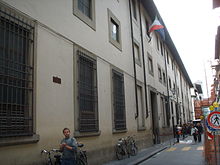Accademia Gallery
In 2016, it had 1.46 million visitors, making it the second-most-visited art museum in Italy, after the Uffizi (2.02 million).
History

The Galleria dell'Accademia was founded in 1784 by Pietro Leopoldo, Grand Duke of Tuscany.
In 2001 the "Museo degli strumenti musicali" collection opened. It includes musical instruments made by Stradivarius, Niccolò Amati and Bartolomeo Cristofori which were acquired by the Florence Conservatory.
In 2023, the museum successfully sued a magazine publisher for using an image of Michelangelo's David without the museum's permission, even though the artwork (which is physically in the museum) belongs to the public domain. The museum also objected to GQ Italia using a lenticular cover to switch between an image of the statue and Pietro Boselli.
Works
The Galleria dell'Accademia has housed the original David by Michelangelo since 1873. The sculpture was allegedly brought to the Accademia for reasons of conservation, although other factors were involved in its move from its previous outdoor location on Piazza della Signoria. The original intention was to create a "Michelangelo museum", with original sculptures and drawings, to celebrate the fourth centenary of the artist's birth. Today, the gallery's small collection of Michelangelo's work includes his four unfinished Prisoners, intended for the tomb of Pope Julius II, and a statue of Saint Matthew, also unfinished. In 1939, these were joined by the Palestrina Pietà, discovered in the Barberini chapel in Palestrina, though experts now consider its attribution to Michelangelo to be dubious.
Other works on display are Florentine paintings from the 13th and 16th centuries, including works by Paolo Uccello, Domenico Ghirlandaio, Sandro Botticelli and Andrea del Sarto; and, from the High Renaissance, Giambologna's original full-size plaster modello for the Rape of the Sabine Women. As well as a number of Florentine Gothic paintings, the gallery houses the collection of Russian icons assembled by the Grand Dukes of the House of Lorraine, of which Leopoldo was one.
References
- ^ "Official Italian visitor figures, 2016" (PDF). Archived from the original (PDF) on 10 January 2017. Retrieved 12 July 2017.
- ^ Dafoe, Taylor (1 June 2023). "A Florence Museum Won Its Lawsuit Against a Publisher That Used a 'Mortifying and Humiliating' Image of Michelangelo's 'David'". Artnet News.
- ^ Bandara, Pesala (5 June 2023). "Museum Wins Lawsuit Over Photo of Michelangelo's David". PetaPixel. Retrieved 6 June 2023.
- ^ Accademia Gallery Polo Museale Fiorentino: Soprintendenza Speciale per il Patrimonio Storico, Artistico ed Etnoantropologico e per il Polo Museale della città di Firenze. Accessed June 2013.
